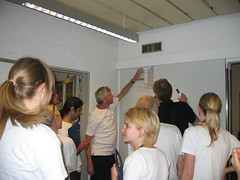At the weekly staff meeting today we discussed our experiences from the ‘Archaeology-of-contemporary-biomedicine-garbage-day’ last Thursday (see earlier post with pics here). Here are some of the points that came up in the discussion:
- We were happily surprised by the interest and generosity that researchers and technicians at the medical faculty showed for the collection project; i.e., people were expecting us, they took the project seriously, and some of them had prepared objects for delivery several days in advance.
- Throughout the day we established lots of useful contacts with people in different premed departments for later collecting forays.
- Many researchers and technicians took the opportunity to tell anecdotes and stories from the lab — thus sustaining earlier experiences among oral historians that ‘things elicit narratives’.
- This was a perfect opportunity to present the Medical Museion concept to the whole faculty; we have increased our visibility considerably; in other words, it was an excellent internal faculty media stunt.
- It was a great experience to do this large-scale logistic collecting exercise together as a group (here are some of us at 8 AM: Ion shows the outline of the Panum Institute on the map):

- The Technical Department were very helpful, both in the planning process and during the hectic morning hours.
- We would of course had gotten much more out of the day if we had been better prepared. It was pretty frustrating to see how the containers were filled up with tons of stuff we didn’t have time to look at. So for future excercises it’s imperative to involve researchers and technicians in the planning process.
- It was interesting to hear what researchers and technicians spontaneously understood by ‘museum objects’, like: “you cannot be interested in this one? It’s not old enough, is it?”. That is, scientific practitioners didn’t identify objects as potential museum objects if they were still in use — it was only when the objects had been set aside in the basement deposits that they were identified as such.
- We collected very little archival material — either because it had already been thrown out (like these un-identifiable lab protocols):

or because people didn’t want to give them away.
- In some cases we found material that researchers and technicians didn’t wish to give us because they wanted to keep it for their “own museum” — in other words, there seems to be several small clandestine museum collections around the Panum Institute.
(more pictures here)


